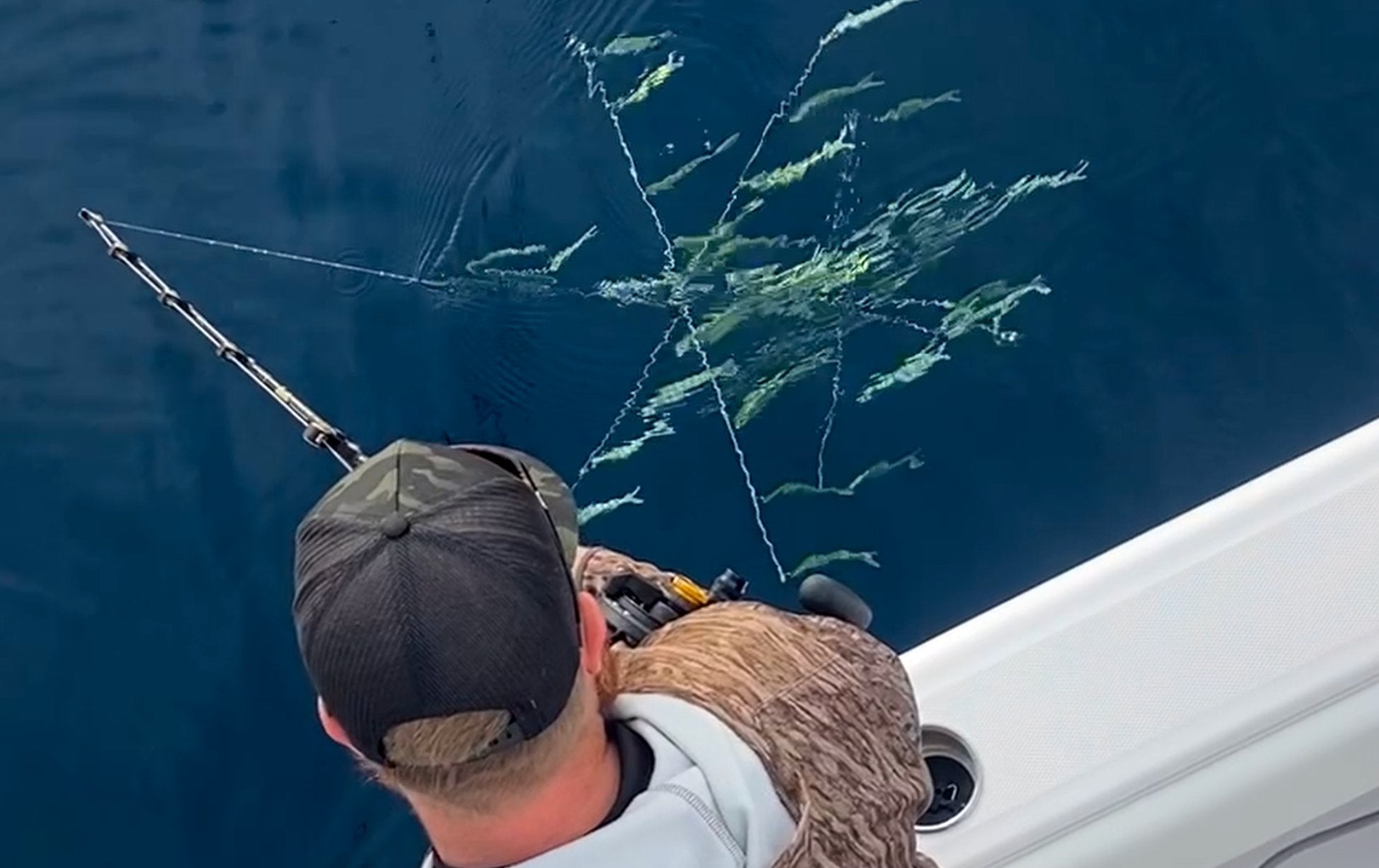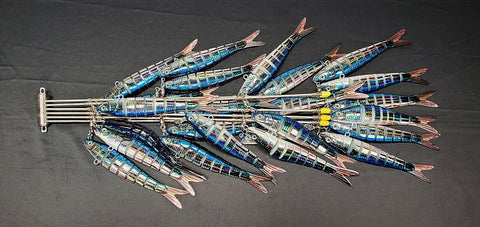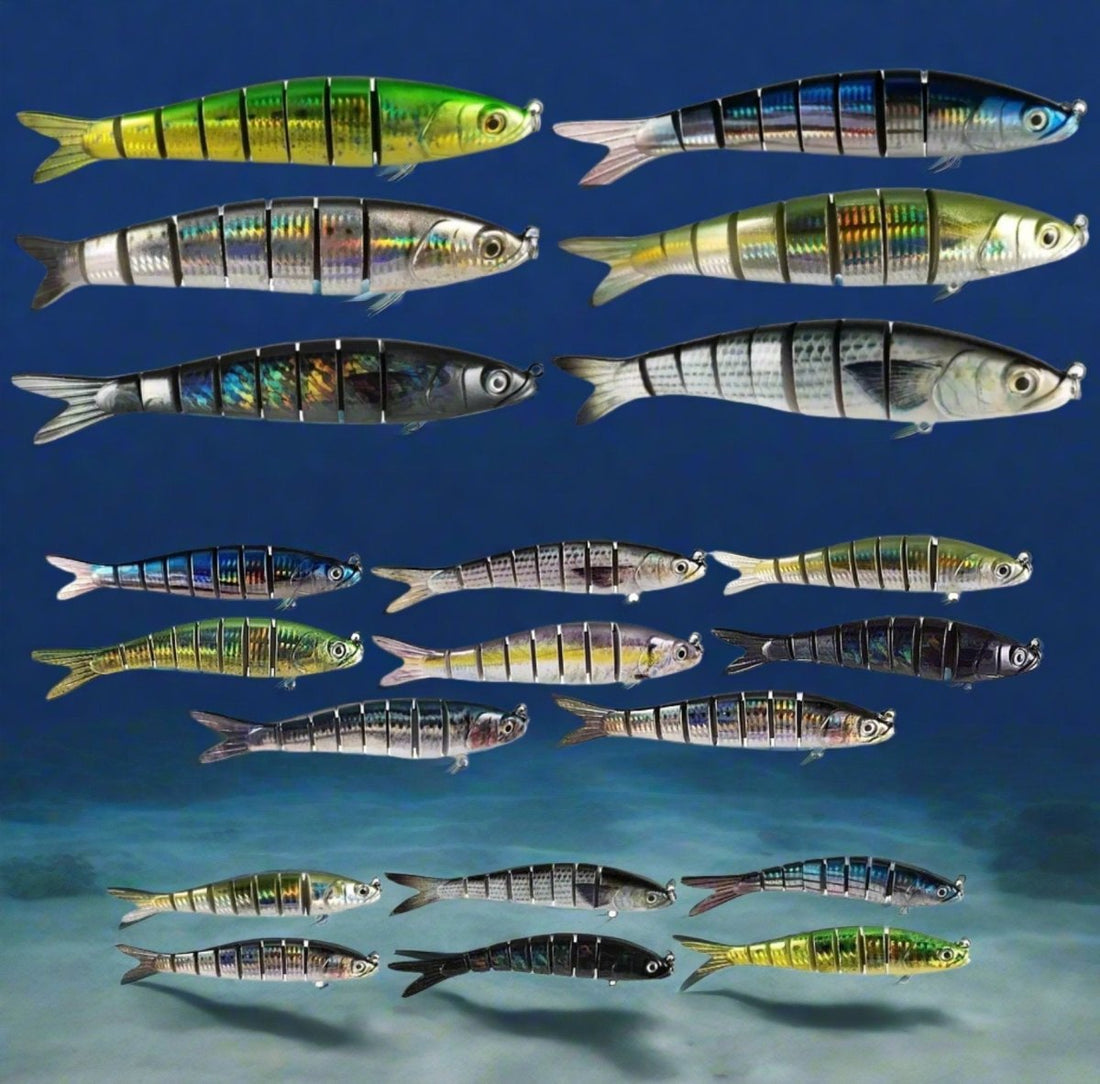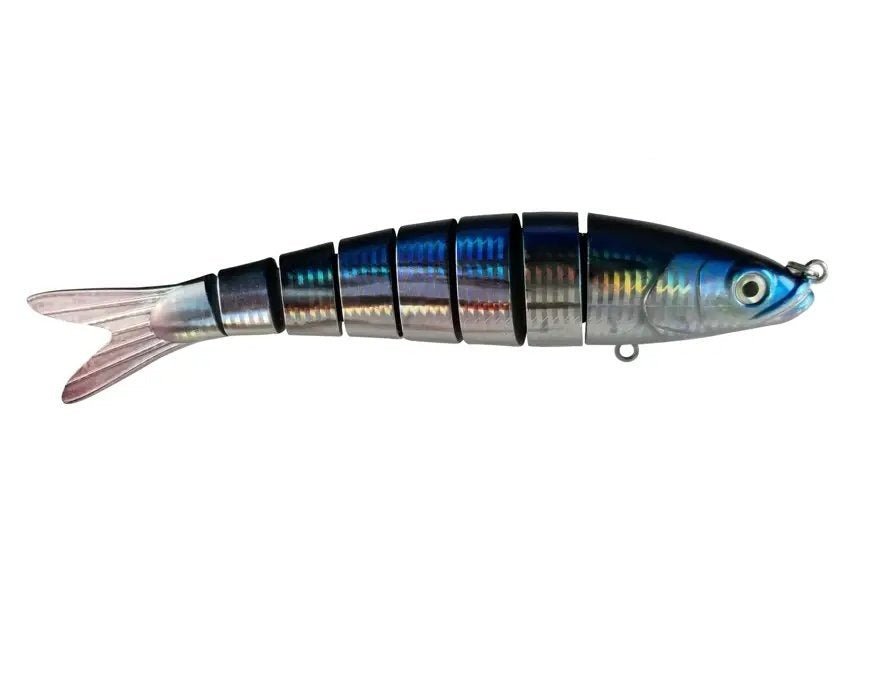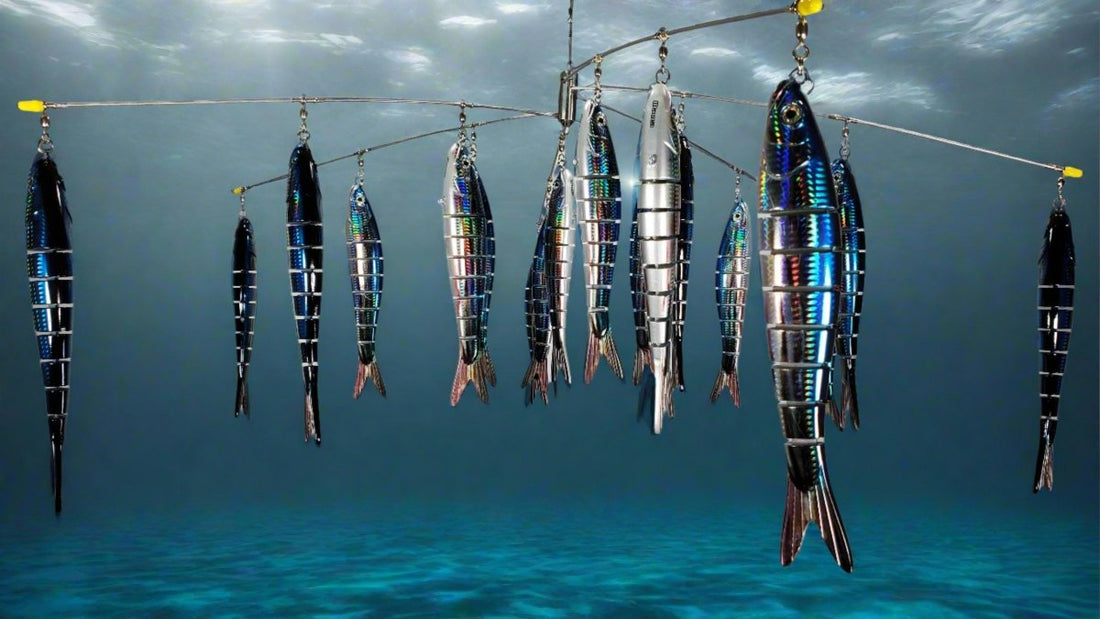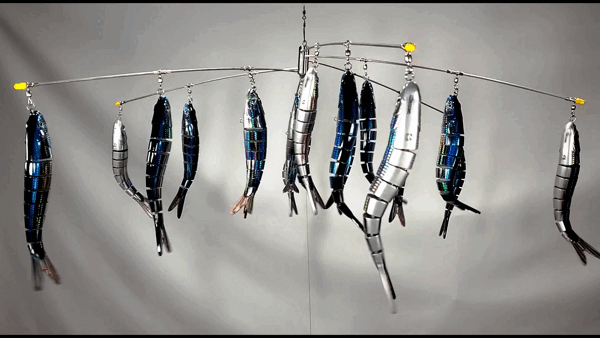Basics of Dredge Fishing Offshore
Dredges are one of the greatest developments over the last few decades. Traditional teasers, spreader bars and daisy chains are still a mainstay in any saltwater angler's box of trolling strategies, however dredges provide one of the most crucial dimensions to any spread by bringing the fish up within striking distance. Deploying a single or multiple dredge systems provide anglers with an excellent opportunity to raise just about any pelagic gamefish through resembling a live baitball swimming behind the boat.
A dredge is pretty much a six-armed umbrella rig on steroids with several connection points off each arm, also known as drops. Unlike the ever popular umbrella rig, a dredge is rigged with hookless baits or lures position in a bait ball configuration designed to entice any pelagic. The drops are trailed by a combination of hookless lures, rigged natural baits, or soft plastic squids generating the illusion of a natural bait-ball below the surface.
Rigging
By presenting a larger profile, offshore game fish such as Dorado, Yellowfin Tuna, Sailfish, and Marlin quickly shift focus on the vibrations and magnitude of flash produced from a dredge. Running surface teasers often lacks replicating the dredge's level of intentional disturbance. Many options exist on the market from different dredge designs to configurations including 4-arm, 6-arm or 8-arm dredges. These can be custom rigged with single, double, or triple tiers. Regardless the size of your teaser, the objective is to resemble the appearance and vibrations of a tightly swimming baitball.

A manual or electric downrigger with a minimum 4-foot boom will work as a cost effective deployment system, which keeps the dredge spaced out, away from the boat like an outrigger. If possible, look for a 6-8ft dredge boom as this will only give your spread more dimension while also keeping the dredges out of the prop wash. This is crucial piece of equipment when fishing out of a triple or quad powered outboard center consoles as the dredge tow line may be damaged by constant friction against the outside engine cowlings when making adjustments. It's also important that it's rigged to handle the weight and resistance of a dredge, requiring a simple pulley system.
Prefessionally rigged with artificial or natural baits, dredges are so deadly effective that often times are the decisive factor between getting bit or getting skunked. While artificial offerings are favored for ease of rigging, natural baits still are holding their own in tournaments worldwide, while making game fish bring their appetite. The biggest tradeoff for presenting the real thing are countless hours rigging never ending hookless baits. During a steady bite, crews can easily go through dozens of rigged baits within a few hrs, especially if bonito and meat fish are chewing. Mullet and Ballyhoo are the top of the litter when it comes to rigging a fish raising dredge. Tinker mackerel and small Bonita are also favored when targeting larger billfish such as Blue or Black marlin.
Top boats around the globe are acutely aware how valuable deploying multiple dredges in their spreads is to their hookup ratio. Most won't care to share that by dropping back a double or triple stack of each corner of the boat and positioning them anywhere from 20-80ft back will be the one getting bit! A properly presented dredge is lethal and will quickly drive up fish from the depths into your bite zone, so a very attentive crew is not only preferred but mandatory to capitalize on a lightning fast strike. Detailed rigging is what will replicate a natural swimming bait-ball and is the name of the game here. It's simple, the bigger the bait-ball, the more ruckus in the water, the higher your hook up ratio soars by raising more actively engaged predators.
Bring Back Ups
Bring spare dredge sets are not only suggested by required as the might ocean's predators will quickly pick apart your offerings without you knowing. Backups are needed because bad things can and do happen:
- Accidentally cutting your dredges off by a hot fish shearing through your line
- Dredge arms become weak and bend or break over time with heavy use
- And unexpectedly explosive bites from wahoo, mako sharks, sailfish and marlin can completely wipe out your dredges. We're talking about attacks where the fish charges up through the dredge, destroys it, and jumps away wearing your dredge as a . Bites like this are awesome to witness, but truly suck when losing all that gear at one time.
Capt. Jimmy Brown of Jaruco Sportfishing, runs the custom built - 90ft Jarret Bay named Jaruco and calls Los Suenos , Costa Rica his homeport. We recently caught up with him and asked Jimmy which style dredge baits are his favorite to pull? Jimmy said, "I place a big emphasis on low drag dredge baits that allow me to add more baits to build a denser looking dredge to more closely mimic a bait school."

Photo credit 📷 : James Brown @jaruco_sportfishing
Dredge Baits:
Dredge bait selection may vary and is typically dictated by the species you're looking to target. Offerings can range from faster trolled artificial teasers to slower trolled natural baits. It’s also common for seasoned crews to deploy one natural baits on one side while sending down artificial baits on the other. Tough tournament conditions will also require teams to make quick adjustments and rig their dredges using all natural baits like a mullet or ballyhoo.
Regardless of what dredge bait is chosen it's vital they track true, with every bait precisely rigged to avoid any spinning. When fishing natural baits, like fresh mullet ,a poorly rigged and spinning bait, places extra drag on the dredge and the unnatural motion of a spinning fish can easily spook incoming fish. Keeping your dredge consistent with similar profiles and baitfish colors will also shape the baitball to look more natural. Avoid mixing up bait sizes or profiles as this will unbalance the dredge will cause the dredge to track incorrectly.
The combination of baits should look like a school of fish swimming tightly in a ball. Most baitfish tend to gather in larger numbers, swimming tightly together to avoid predation from larger gamefish such as marlin, dorado, yellowfin tuna, sailfish and many other pelagics. The larger the bait-ball, the more vibration traveling through the water column easily alerting any gamefish patrolling nearby.
Deployment
 Most would wonder how far behind the boat other captains are pulling their dredges? If you ask any seasoned dredge skipper his response would simple be, that's a loaded question! Several variables such as rigger size & angle, speed of current, boat speed, amount of whitewater and size dredge weight are just a few factors that dictate how deep and how quickly a captain pulls his dredge.
Most would wonder how far behind the boat other captains are pulling their dredges? If you ask any seasoned dredge skipper his response would simple be, that's a loaded question! Several variables such as rigger size & angle, speed of current, boat speed, amount of whitewater and size dredge weight are just a few factors that dictate how deep and how quickly a captain pulls his dredge.We wanted the latest information available, so turned to some of the heavy weights in today's competitive dredge fishing arenas. The goal was simply to get feedback on proven techniques that converted into consistent results time and time again.
Capt. Jimmy Brown, running the Jaruco, a 90ft Jarret Bay, doesn't really have a catch all dredge style, instead prefers to try to match the bait believed to be in the area. "When it comes down to dredge position, the best tactic for us is positioning the dredge as far back as possible without it interfering with a tease and switch scenario. We always want to have our dredge beat the teaser back to the boat. Having an efficient pull down set up is also essential to allow you to continue fishing the dredge in the turn", said Jimmy.
We asked Capt. Chris Donato, based out of Hawaii, what are the most important factors to consider when building a dredge? Chris said," I always believe that movement and vibration are key to raising fish and keeping them in close to your spread. I really like firetailz baits because they are light and have a very realistic movement to them although many other baits will work. My theory on a good dredge is that the ball of mass with all the vibration and movement can send out added profile to a fish that may be out of sight of your spread."

When it comes to checking the baits, keep a close on our dredges and check them often, especially if you're cruising along weedlines.
A dredge's wide profile acts like a rake and pretty much scoops up any piece of sargassum that crosses it's path.
The ideal scenario would be retrieving the dredge while connected to a fish but if not, keeping an eye on the baits hourly prevents missing any raised fish to feed.
Fresh mullet typically holds better and the last thing you want if for them to washed out taking away the mass and scent left on the bait. If they begin to break up, change them as needed throughout the day.
The dredge teaser is by far one of the most productive teasers of modern sportfishing but the key is to find a setup that works best for you. Years ago, dredge fishing was primarily used just for the hardcore sail fishing guys, but as tournaments expand release categories and payouts, dredges are finding their way onto more decks in the Gulf, the Bahamas and the Caribbean. In Puerto Rico and the Dominican Republic where Striped and Blue Marlin frequent the edge, dredges are a staple on any boat targeting billfish. The top skippers run a variety of dredges including natural, artificial, and combination of both to match the local forage, while keeping high hook up ratios.
How to Rig Fishing Dredges
If you're just venturing into the world of offshore dredge fishing, it's safe to say that you've made to commitment to find out what the top-level pelagic skippers and crews rely on daily to keep them tight. Yes, it takes a little more work and effort to deploy and manage a dangerously effective dredge spread, however the pros certainly outweigh the cons.

Most anglers here in Florida and the islands are just looking for that next greatest thing that the "other guy" hanging down current is lacking. Dredges fill the void and at many times the fish box when nothing else is working. Running a properly tracked, single level dredge behind boat will automatically increase your bite ratio dramatically. Essentially, the dredge is replicating a bait ball congregating tightly to the boat and more importantly your trolling spread.
Any seasoned saltwater angler with experience dredge fishing will share that 90% of the work is in the rigging and making sure that the dredge has a nice balance to it. This ensures that the dredge will track correctly and appear more natural in the water when pulled at 8 knots.
The White Marlin open is typically held in Ocean City, Maryland every summer and is the richest ongoing billfish tournament in the world, rivaling the Bisbee's Black & Blue based out of Cabo San Lucas Mexico. An impressive 4.53 Million payout was awarded to the single fish landed breaking records for tournaments worldwide. Some of the world's best gather to compete for the prestigious title and you can rest assured that every boat leaving the dock has several custom rigged dredges on board. The reason being that all participating crews know the power of replicating a bait ball behind the boat and the impact it has on helping raise large billfish nearby. They simply can't resist checking out what's happening when dredges are running behind the boat.
Equipment Checklist
Before you begin rigging a dredge, ensure you have all the necessary equipment:
- Dredge Arms: The frame or arms of the dredge, typically made from metal or heavy-duty plastic.
- Dredge Baits: These can be artificial or natural and are attached to the arms of the dredge.
- Monofilament Line or Cable: To attach baits to the dredge.
- Swivels and Snaps: For connecting the various components securely.
-
Dredge Weight: To help the dredge sink and maintain the desired depth.

Heavy-Duty Fishing Rod and Reel: Capable of handling the weight and drag of a fully rigged dredge such as Lindgren & Pitman 1200, KOBO’s Power Reel, or even Daiwa’s recently upgraded Tanacom 1000 are more than capable to pull anything your dredge can dish out. With that said you can always go the old school manual route and run a few hundred feet of heavy monofilament or some 3/16 red or black poly rope will also get the job done.
Step-by-Step Guide to Rigging a Dredge:
Step 1: Assembling the Dredge Frame
- Start by assembling the frame of your dredge according to the manufacturer's instructions. This typically involves attaching several arms to a central hub. Each arm will hold multiple lines from which the baits are suspended.
Step 2: Attaching the Main Line
- Attach a heavy-duty main line to the central hub of the dredge. This line should be strong enough to handle the significant drag that a fully baited dredge creates. It's often helpful to use a braided line for its strength and durability. One question we often are asked by many of our customers is what mainline material should be used? We simply answer minimum 400lb hard monofilament. We like Momoi hard mono as they have been leaders in the market for many years and have a proven reputation when it comes to big game fishing.
Step 3: Rigging the Baits
- Natural Baits: If using natural baits like ballyhoo or mullet, rig each bait with a hook and monofilament leader. Secure the leader to the dredge arms with crimps to ensure the baits are firmly attached.
- Artificial Baits: For artificial baits like our Motion Teaser Baits, you can typically attach them directly to the dredge arms using snaps or swivels. Make sure they are evenly spaced to create a natural-looking school effect.
Step 4: Adding Weight
- Determine the amount of weight needed based on the fishing conditions and the depth at which you want the dredge to operate. Attach the weight in front of the dredge using heavy-duty corkscrew ball bearing swivels. This is not the place to rely on a typical snap swivel to keep your dredge tackle running smoothly at 6-8 knots with nearly 60lb of drag.
Step 5: Attaching the Dredge to the Fishing Line
- Use a strong, heavy-duty ball bearing corkscrew swivel to attach the dredge line to your fishing line. This connection must be very secure, as it will bear the full force of the dredge's movement through the water.
When it comes to the complete setup, we're running the 400lb mono crimped to a 500lb ball bearing screw lock swivel with a welded solid ring. The reason we always recommend monofilament above anything is that mono has some stretch or give and that's exactly what is required when you’re trolling with a 6-10lb lead weight rigged in front of a dredge configuration that can vary from 2-15lbs. Add everything up and that's a lot of weight & drag running through the water. A little give is exactly what you want to achieve the proper tracking for the dredge. The screw-lock portion is then twisted onto the top eye of the vinyl or rubber coated fish lead. Yes we said rubber or vinyl coated fish lead rather than the standard lead finish as this will help protect the deck of the boat from being damaged when the dredges are brought aboard.

The eyelet located on the back fin of the fish lead is where you will want to connect the rigging portion to your dredge. This will consist of a 3-4ft section of stranded stainless-steel cable crimped to a 500lb screw-lock ball bearing dredge swivel with solid ring eye on each. Heat shrinking the crimped ends will also help keep the rigging clean and streamline to extended use.
The weight of the fish lead will vary as you want to have a few weight sizes on board so that you can quickly adapt to changes in conditions while trolling. We’re tested heavy 48 & 64oz inline wahoo trolling leads to see if we could get away with using them on a single tier dredge weighing it around 2lbs and on a calm day with minimal current they will track just fine.
Tips for Effective Dredge Fishing
Test Your Rig:
- Before deploying your dredge, test it in clear water if possible, to ensure it swims correctly and the baits behave as intended.
Monitor and Adjust:
- Keep an eye on your dredge during use. It may require adjustments, especially if you notice it's not running straight or the baits aren't displaying properly.
Use Varying Baits:
- Mix up the types and sizes of baits on your dredge to mimic a natural school of fish more effectively however keep in mind to balance baits accordingly through the dredge. Predators are often attracted to variety and movement.
Safety First:
- Dredges can be heavy and cumbersome. Always handle with care, and most savvy crew tend to use gloves particularly when deploying and retrieving.
Rigging a dredge properly is essential for successful offshore fishing. It requires attention to detail in the assembly and setup to ensure that the simulation of a bait school is as realistic as possible. By following these steps and continually refining your technique, you can significantly increase your chances of attracting game fish. Remember, the key to effective dredge fishing lies not only in the rig but also in how well it integrates with your overall fishing strategy. Whether you're new to using dredges or looking to refine your skills, the effort you put into rigging your dredge can make all the difference in your fishing success.
This setup will get you going with a single tier (stack) however to deploy multiple stacks the process is simply repeated in between each dredge hub. The dredge hub is the center point used to connect successive dredges. Each hub has a top eyelet and bottom eyelet to be used as a connection point. There are several types of dredge hubs and arms available on the market. Our suggestion is to find the heaviest gauge you can find as almost all dredge arms manufactured are prone to breakage under extreme loads.
Lastly, It's important to remember that maintaining the dredge and keeping it clean will allow for many uses and multiple catches. A simply light freshwater rinse at the dock to the fish weight, hub, arms, baits, and rigging assembly will go a long ways when it comes to overall performance. If you want to take it to the next level as I often do, then wiping off any excess moisture or humidity before stowing it away will keep your dredges tracking like new!
Crush MORE Mahi Mahi using Dredges
Mahi-mahi, also known as dolphinfish or dorado, are among the most sought-after saltwater game fish in the world, prized for their speed, acrobatics, and excellent table fare. These pelagic predators are found in tropical and subtropical waters worldwide, and they are commonly encountered by anglers trolling offshore with artificial lures. We are talking about a fish that can reach weights of well over 40lbs in less than 6 months due to an insatiable appetite. A ray finned species, dolphin exhibit a single long based dorsal fin that extends from the head to the tail. Males, known as bulls, show prominent foreheads projecting out well above the body while females have a rounded head.
 Dorado travel fast to keep up with the abundance of forage cruising the Gulf Stream current. Flying fish, Goggle Eye, Ballyhoo, Spanish Sardine, and Mullet are but a few of the baitfish that can become quick meals for these colorful pelagics. Monster Mahi are found cruising the current rips and edges of any temperature break out in the blue waters of the Atlantic. The species is quickly identified in the open as their electric coloration is the first thing any anglers notices when they are raised up to a dredge.
Dorado travel fast to keep up with the abundance of forage cruising the Gulf Stream current. Flying fish, Goggle Eye, Ballyhoo, Spanish Sardine, and Mullet are but a few of the baitfish that can become quick meals for these colorful pelagics. Monster Mahi are found cruising the current rips and edges of any temperature break out in the blue waters of the Atlantic. The species is quickly identified in the open as their electric coloration is the first thing any anglers notices when they are raised up to a dredge. Lines of weed or sargassum build up along current rips and provide the ideal habitat to local a pack of hungry dolphin. The sargassum provides a very healthy ecosystem for smaller baitfish and a variety of other marine life. Dolphin lurk in the depths waiting to ambush any baitfish straying too far from the shelter of these weed mats which at times can be the length of a football field.
One tactic that has proven particularly effective for targeting mahi-mahi is the use of high-quality dredges featuring artificial lures with natural baitfish patterns. In this article, we'll explore the benefits of this approach and provide tips for using it effectively.
The Benefits of High-Quality Dredges

A dredge is essentially a spread of multiple artificial lures, often rigged in a way that mimics a school of baitfish. The goal of a dredge is to create the illusion of a large, active school of prey, which can entice mahi-mahi to strike.
The benefits of using a high-quality dredge for targeting mahi-mahi are numerous:
Increased Attractiveness
One of the primary benefits of a dredge is that it significantly increases the attractiveness of your trolling spread. By presenting multiple lures in a way that mimics a school of baitfish, a dredge can make your spread look much more enticing to passing mahi-mahi.
Improved Visibility
Another key advantage of a dredge is that it can improve the visibility of your trolling spread. By positioning multiple lures at different depths and angles, a dredge can create a more visible, three-dimensional target that is easier for mahi-mahi to detect from a distance.
More Strikes
Ultimately, the goal of using a dredge is to increase the number of strikes you get from mahi-mahi. By presenting a more attractive, visible target, a dredge can entice more strikes and increase your chances of hooking up with these elusive game fish.

Creating your own baitfish ball, also known as a "bait ball" behind the boat would be the ideal strategy to raise the larger dolphin lurking below and deploying a properly presented dredge will only get any nearby Mahi frenzied up!
In scenarios like this is, deploying a dredge system that matches the profile and colors of the bait in the area will only help maximize how much Mahi you put in the box. Dredges can be rigged in variety of sizes, shapes, and colors. They can have fixed or collapsible arms that aid in the ease of storage. Whichever way you decide to go, just make sure the materials, baits, and components used are ready to withstand several mahi strikes.
Sticking to a 5 - 7" baitfish profile is a good rule of thumb as this size footprint is needed to generate the right amount of flash, vibration, and disturbance to ring the dinner bell. Utilizing multiple drops per arm of the dredge will add more weight the dredge but also create the appearance of a densely packed bait ball. A dredge with a diameter of at least 3 ft, will typically have 3 - 5 drops per arm. The drop is the location on the arm of the dredge where the baits are connected, usually with a crimp sleeve swivel.
When rigging the dredge, evenly spacing out the baits to minimize wear and maximize performance is a must. This will also help create a tightly formed baitball which is what will help raise the larger mahi below. When it comes to selecting natural baits over artificial, seasoned offshore skippers will run a mix of both. Some prefer an all natural mullet dredge as this is a standard producer. Natural baits provide the natural sense of smell and swimming action when properly rigged, but will also wash out after each use. Artificial baits come a variety of styles and shine when it comes to durability and creating "the ruckus" to bring up the big boys.

Deploying anywhere from a 4 - 6lb fish style lead weight rigged on 400lb stranded cable or hard mono in front of the dredge should help keep your single, double, or triple tier dredge tracking right. It's always a good idea to have a few weights on deck so you can adjust to the sea conditions quickly and optimize the way the dredge tracks through the water. Always try to use the least amount of weight possible in front of the dredge and use only what's needed to get the dredge swimming correctly.
 If you're ready to take on more mahi action and stay connected with a steady flow gaffers headed for the box, then making dredge deployments part of your spread may be the answer. Keeping a keen eye out for the abundant bait in the area and shaping your dredge to replicate that forage swimming in a bait ball will increase your chances of success. The valuable time spent deploying and retrieving your dredges will become more natural with time and quickly turn into a finely tuned offshore fishing orchestra as practice makes perfect and fine tuning the dredges with an able and willing crew will help keep those fish boxes filled. Spending the time together with your crew to make each dredge deployment seem like second nature and get your team on a bite with consistency.
If you're ready to take on more mahi action and stay connected with a steady flow gaffers headed for the box, then making dredge deployments part of your spread may be the answer. Keeping a keen eye out for the abundant bait in the area and shaping your dredge to replicate that forage swimming in a bait ball will increase your chances of success. The valuable time spent deploying and retrieving your dredges will become more natural with time and quickly turn into a finely tuned offshore fishing orchestra as practice makes perfect and fine tuning the dredges with an able and willing crew will help keep those fish boxes filled. Spending the time together with your crew to make each dredge deployment seem like second nature and get your team on a bite with consistency.
Slow Trolling Using Fishing Dredges
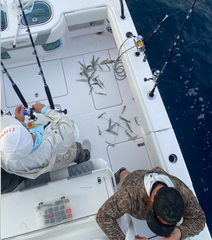
In the exciting world of saltwater sportfishing, few techniques can match the effectiveness and thrill of slow trolling using fishing dredges. As a seasoned captain plying the azure waters off Florida's coast & the Bahamas, I've learned to hone down certain techniques over years & turning it into an art form that consistently yields impressive catches. In this comprehensive guide, I'll share my insights and experiences from friends and fellow skippers at the top of their craft to help maximize your bites and elevate your slow trolling game.
Understanding the Basics of Slow trolling with dredges
Slow trolling with dredges is a method designed to create an irresistible illusion of a school of baitfish, thereby attracting predatory game fish. A dredge is a multi-armed frame, typically circular, to which numerous lures or baitfish (natural or artificial) are attached. When towed behind the boat, it mimics a small school of fish, a sight that game fish find hard to ignore. It’s quite simple, don’t you think any predator within a half mile radius will feel those vibrations and stress signals given off by the dredge (s) deployed behind your vessel and come see what’s going on? You bet!
The Right Gear & Right Crew
To get started, you need the right gear. A typical setup includes a heavy-duty bent butt fishing rod or dredge boom and conventional reel, a sturdy dredge, and an assortment of baits or lures. I prefer high-quality, co-polymer or monofilament lines for their strength and durability, especially when targeting larger species like marlin or sailfish. I choose mono as the stretch found in traditional monofilament is needed to absorb the shock to the line when the boat is traveling between waves or sea conditions change as they do so often in Florida and the Caribbean. Perhaps just as vital is having a dedicated crew that works in unison when deploying and retrieving the dredges, positioning & presenting the baits perfectly alongside the dredges. A well-seasoned captain running his crew orchestrates every change in the spread and a well-tuned in crew will eliminate miss opportunities.
Dredge Selection & Rigging

Choosing the right dredge is crucial. Not all dredges are created the same and extensive rigging and tuning in the dredge to swim as lifelike as a real bait ball behind the boat. There are various types available, from simple 6-arm frames to more complex 12-arm or even 24-arm structures. The choice largely depends on your target species and the local fishing conditions. In Florida, where we fish, we often use a heavy gauge wire, 6-arm dredge rigged with artificial baits for versatility and durability. We’ve found that a lighter dredge, rigged with 5”- 8” baits, like our Motion Teaser Baits, work well for most species we target here like sailfish, mahi-mahi, king mackerel, blackfin tuna, or wahoo. Going to big on the baits will create more drag in the water, which in turn means may take a little bit longer to clear the dredge after a strike and every second counts to get the fish to the boat.

Rigging the dredge properly is key. Ensure that the baits are securely attached and evenly spaced. The goal is to create the most natural-looking bait ball possible. Some anglers prefer artificial baits for ease of use and durability, while others swear by the effectiveness of natural bait. I often use artificial teaser baits, such as Fire Tailz strips or Motion Minnow Teaser baits, eliminates the thought of constantly having to worry about your natural baits washing out or falling off or clipped by a toothy critter down below.
Boat Handling and Speed for slow trolling
Boat handling is critical in slow trolling. The idea is to move just fast enough to keep the dredge and baits swimming realistically. Typically, this means maintaining a speed of 2-4 knots, depending on the sea conditions and the target species. The sea state, speed of current, and strength of wind will dictate what will be the ideal speed to move your live baits behind the dredge in position to consistently get bit. It's important to adjust your speed to ensure that the dredge swims just below the surface, creating the most natural presentation.
Tactical Considerations

When slow trolling with a dredge, it’s not just about dragging a bait ball behind the boat. It's about creating a scenario that piques the interest of predatory fish. This means considering the direction of your troll relative to the current and wind, the depth at which you're fishing, and the type of bottom structure below.
In our experience, predatory fish such as sailfish, wahoo, or tuna often attack from below or behind the dredge. Therefore, we always keep a few lines rigged and ready to drop back immediately when I notice a following fish. This quick response can often turn a curious follower into a solid hookup.
For Maximizing Bites
The real secret to maximizing bites lies in the details. Pay attention to how the fish are reacting to your spread. If you notice followers but no bites, consider changing up your bait presentation or adjusting your trolling speed. Sometimes, simply altering the color or size of the baits can make a huge difference. Matching the hatch has been HUGE to my success. For example, if you hear through the grapevine from buddies that tinker mackerel have been around in numbers, then it might be good to load up the dredge with baits replicating a tinker.
Additionally, I often use teaser lines and additional lures in conjunction with the dredge to create an even more enticing scene. The combination of a well-presented dredge and strategically placed teasers can be irresistible to game fish. An inline daisy chain of fish imitations or squid work well in helping draw more attention to your spread.
Safety and Conservation
While focusing on maximizing bites, it's essential not to overlook safety and conservation. Always ensure that your gear is in good condition and that you're following all local regulations and guidelines. As a responsible angler, be sure to practice catch and release whenever possible, especially with endangered or highly targeted species such as sailfish.
Conclusion
Slow trolling with fishing dredges is a highly effective technique that, when executed correctly, can yield remarkable results. It combines the thrill of sportfishing with the satisfaction of mastering a sophisticated angling method. By understanding the basics, choosing the right gear, and paying attention to the finer details, you can significantly increase your chances of a successful outing.
Remember, every day on the water is an opportunity to learn and improve. So, gear up, head out, and experience the joy of deploying your deadly dredges. Here's to tight lines and getting bit!
-Capt. Carlos


